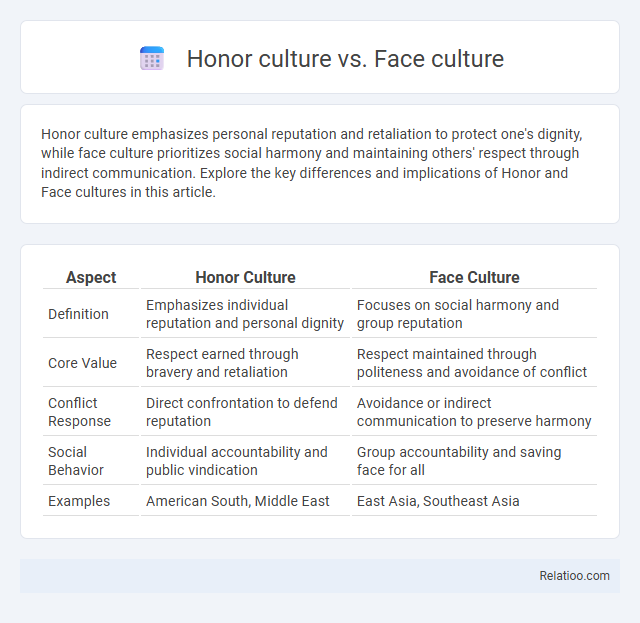Honor culture emphasizes personal reputation and retaliation to protect one's dignity, while face culture prioritizes social harmony and maintaining others' respect through indirect communication. Explore the key differences and implications of Honor and Face cultures in this article.
Table of Comparison
| Aspect | Honor Culture | Face Culture |
|---|---|---|
| Definition | Emphasizes individual reputation and personal dignity | Focuses on social harmony and group reputation |
| Core Value | Respect earned through bravery and retaliation | Respect maintained through politeness and avoidance of conflict |
| Conflict Response | Direct confrontation to defend reputation | Avoidance or indirect communication to preserve harmony |
| Social Behavior | Individual accountability and public vindication | Group accountability and saving face for all |
| Examples | American South, Middle East | East Asia, Southeast Asia |
Understanding Honor Culture: Core Principles
Honor culture emphasizes personal reputation, social standing, and the defense of one's name through actions that demonstrate strength and integrity. Key principles include maintaining respect within the community, responding to threats with assertiveness, and upholding family and lineage honor as a collective responsibility. Honor culture often contrasts with face culture, which prioritizes social harmony and avoiding public embarrassment over direct confrontation.
Defining Face Culture: Key Values
Face culture emphasizes maintaining social harmony, respect, and avoiding shame through careful interpersonal conduct and reputation management. Core values include humility, indirect communication, and preserving group cohesion by preventing embarrassment or loss of face. This cultural framework prioritizes collective honor and relational balance over individual assertiveness or retribution.
Historical Roots of Honor and Face Cultures
Honor culture originates from societies emphasizing individual reputation and retaliation to preserve social standing, deeply rooted in ancient Mediterranean and Middle Eastern communities. Face culture derives from East Asian traditions prioritizing social harmony, respect, and group cohesion, with origins in Confucian philosophy emphasizing relational interdependence. Both cultures manifest distinct behavioral norms shaped by historical contexts influencing contemporary social interactions and conflict resolution strategies.
Social Dynamics in Honor vs Face Societies
Honor culture revolves around individual reputation maintained through direct personal actions and retaliations, emphasizing courage and respect in social interactions. Face culture prioritizes social harmony and relational saving by avoiding public embarrassment and valuing indirect communication within community contexts. Your understanding of social dynamics must consider that honor societies often encourage assertiveness and personal justice, while face societies promote group cohesion and conflict avoidance.
Conflict Resolution: Honor Culture vs Face Culture Perspectives
Honor culture emphasizes direct confrontation and retaliation to defend personal or family reputation, often leading to aggressive conflict resolution strategies. Face culture prioritizes preserving social harmony and avoiding public embarrassment, encouraging indirect communication and compromise to resolve disputes. Your approach to conflict will depend on whether maintaining dignity through assertiveness or ensuring collective respect through subtlety is more valued.
Family and Community Roles
Honor culture emphasizes maintaining family reputation through loyalty and retributive justice, positioning family roles as protectors and enforcers of social norms. Face culture prioritizes social harmony and respect, with community roles centered on preserving dignity and avoiding shame through indirect communication. Your interactions within these cultures shape how responsibilities are distributed, favoring either collective honor or mutual respect in family and community dynamics.
Communication Styles: Directness vs Indirectness
Honor culture emphasizes direct communication to assert reputation and resolve conflicts swiftly, while face culture relies on indirect communication to maintain social harmony and avoid embarrassment. Your interaction in honor cultures often involves candid expression and clear confrontation, contrasting with the subtle, context-dependent cues common in face cultures. Understanding these communication styles helps navigate social expectations and prevent misunderstandings across cultural contexts.
Reputation, Shame, and Social Consequences
Honor culture places high value on personal reputation and reacts strongly to challenges with direct retaliation to restore status, emphasizing public recognition of bravery and loyalty. Face culture prioritizes maintaining social harmony and avoiding shame through indirect communication and preserving dignity in community interactions, focusing on subtle social cues to save face. Shame culture centers around collective moral standards where individuals experience internal guilt when failing societal expectations, leading to social exclusion as a primary consequence.
Honor and Face Culture in the Modern World
Honor culture emphasizes personal reputation and social standing based on courage and respect, often manifesting in direct responses to perceived slights to defend one's dignity. Face culture prioritizes maintaining social harmony and avoiding confrontation by upholding respect and saving face through subtle communication and indirect conflict resolution. Understanding the nuances of Honor and Face cultures can help you navigate social interactions and conflicts more effectively in diverse modern environments.
Navigating Cross-Cultural Interactions
Navigating cross-cultural interactions requires understanding distinct value systems like honor culture, which emphasizes reputation and personal valor, versus face culture, where social harmony and avoiding shame are prioritized. Honor cultures often thrive in individualistic societies with clear boundaries and retaliation norms, while face cultures prevail in collectivist societies focused on maintaining group cohesion and respectful communication. Recognizing these differences enables more effective communication, conflict resolution, and relationship-building across diverse cultural contexts.

Infographic: Honor culture vs Face culture
 relatioo.com
relatioo.com